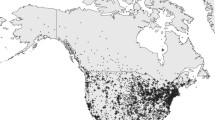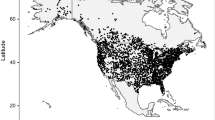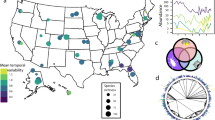Abstract
Different species in a given site or population of a given species in different sites may fluctuate in synchrony if they are affected similarly by factors such as spatially autocorrelated climate, predation, or by dispersal between populations of one species. We used county wise time series of hunting bag records of four Norwegian tetraonid species covering 24 years to examine patterns of interspecific and intraspecific synchrony. We estimated synchrony at three spatial scales; national, regional (consisting of counties with similar climate), and county level. Ecologically related species with overlapping distributions exhibited strong synchrony across Norway, but there was much variation between the different regions and counties. Regions with a long coastline to both the North Sea and the Norwegian Ocean exhibited an overall stronger synchrony than those consisting of more continental areas. Intraspecific synchrony was generally low across all counties, but stronger synchrony between counties within regions defined by climatic conditions. Synchrony was negatively related to distance between populations in three of four species. Only the synchrony in willow ptarmigan showed a clear negative relationship with distance, while the other species had both strong positive and negative correlations at short distances. Strong interspecific synchrony between some species pairs within regions and weak intraspecific synchrony across counties within regions suggest a stronger synchronizing effect from environmental factors such as weather or predation and less effect from dispersal. Our results suggest that the complete tetraonid community is structured by environmental factors affecting the different species similarly and causes widespread interspecific synchrony. Local factors affecting the population dynamics nevertheless frequently forces neighbouring populations out of phase.





Similar content being viewed by others
References
Bates D (2005) Fitting linear mixed models in R. R News 5:27–30
Bergerud AT, Gratson MW (1988) Survival and breeding strategies of grouse. In: Bergerud AT, Gratson MW (eds) Adaptive strategies and population ecology of northern grouse. University of Minnesota Press, Minneapolis, pp 473–577
Borger L, Franconi N, De Michele G, Gantz A, Meschi F, Manica A, Lovari S, Coulson T (2006) Effects of sampling regime on the mean and variance of home range size estimates. J Anim Ecol 75:1405–1493
Butler L (1953) The nature of cycles in populations of Canadian mammals. Can J Zool (Rev Can De Zool) 31:242–262 (Chaps. 244, 245)
Cattadori IM, Merler S, Hudson PJ (2000) Searching for mechanisms of synchrony in spatially structured gamebird populations. J Anim Ecol 69:620–638
Cattadori IM, Haydon DT, Thirgood SJ, Hudson PJ (2003) Are indirect measures of abundance a useful index of population density? The case of red grouse harvesting. Oikos 100:439–446
Erikstad KE (1985) Growth and survival of willow grouse chicks in relation to home range size, brood movements and habitat selection. Ornis Scand 16:181–190
Erikstad KE, Andersen R (1983) The effect of weather on survival, growth and feeding time in different sized willow grouse broods. Ornis Scand 14:249–252
Grenfell BT, Wilson K, Finkenstadt BF, Coulson TN, Murray S, Albon SD, Pemberton JM, Clutton-Brock TH, Crawley MJ (1998) Noise and determinism in synchronized sheep dynamics. Nature 394:674–677
Grotan V, Saether BE, Engen S, Solberg EJ, Linnell JDC, Andersen R, Broseth H, Lund E (2005) Climate causes large-scale spatial synchrony in population fluctuations of a temperate herbivore. Ecology 86:1472–1482
Hornell-Willebrand M, Marcstrom V, Brittas R, Willebrand T (2006) Temporal and spatial correlation in chick production of willow grouse Lagopus lagopus in Sweden and Norway. Wildl Biol 12:347–355
Ims RA, Andreassen HP (2000) Spatial synchronization of vole population dynamics by predatory birds. Nature 408:194–196
Kausrud KL, Mysterud A, Steen H, Vik JO, Ostbye E, Cazelles B, Framstad E, Eikeset AM, Mysterud I, Solhoy T, Stenseth NC (2008) Linking climate change to lemming cycles. Nature 456 (93–U93)
Kerlin DH, Haydon DT, Miller D, Aebischer NJ, Smith AA, Thirgood SJ (2007) Spatial synchrony in red grouse population dynamics. Oikos 116:2007–2016
Linden H (1981) Hunting and tetraonid populations in Finland. Finn Game Res 39:69–78
Lindstrom J, Ranta E, Linden H (1996) Large-scale synchrony in the dynamics of capercaillie, black grouse and hazel grouse populations in Finland. Oikos 76:221–227
Moran PAP (1953) The statistical analysis of the Canadian lynx cycle. II. Synchronization and meteorology. Aust J Zool 1:291–298 (Chaps. 294, 295, 210)
Munkebye E, Pedersen HC, Steen JB, Broseth H (2003) Predation of eggs and incubating females in willow ptarmigan Lagopus l. Lagopus. Fauna norv 23:1–8
Myrberget S (1988) Demography of an island population of willow ptarmigan in northern Norway. In: Bergerud AT, Gratson MW (eds) Adaptive strategies and population ecology of northern grouse. University of Minnesota Press, Minneapolis, pp 379–419
Nilsen EB, Pedersen S, Linnell JDC (2008) Can minimum convex polygon home ranges be used to draw biologically meaningful conclusions? Ecol Res 23:635–639
Paradis E, Baillie SR, Sutherland WJ, Gregory RD (1999) Dispersal and spatial scale affect synchrony in spatial population dynamics. Ecol Lett 2:114–120
Pedersen HC (1991) Hønsefugler. In: Hogstad O (ed) Norges dyr. Fugler 2. Cappelens forlag, Oslo, pp 7–64
Pedersen HC, Karlsen DH (2007) Alt om RYPA; Biologi-jakt-forvaltning. Tun Forlag, Oslo
Ranta E, Lindstrom J, Linden H (1995) Synchrony in tetraonid population-dynamics. J Anim Ecol 64:767–776
Ranta E, Lundberg P, Kaitala V (2006) Ecology of populations. Cambridge University Press, London
Ranta E, Lindstrom J, Linden H, Helle P (2008) How reliable are harvesting data for analyses of spatio-temporal population dynamics? Oikos 117:1461–1468
Seiskari P (1962) On the winter ecology of the capercaillie, Tetrao urogallus, and the black grouse, Lyrurus tetrix, in Finland. Pap Game Res 22:1–119
Slåttå Å, Pedersen HC, Røskaft E (2002) Hunting statistics as a tool in the management of small game focussing on mountain hare (Lepus timidus). NINA Oppdragsmelding 1–27
Small RJ, Marcstrom V, Willebrand T (1993) Synchronous and nonsynchronous population fluctuations of some predators and their prey in central Sweden. Ecography 16:360–364
Smedshaug CA, Selas V, Lund SE, Sonerud GA (1999) The effect of a natural reduction of red fox Vulpes vulpes on small game hunting bags in Norway. Wildl Biol 5:157–166
Steen H, Erikstad KE (1996) Sensitivity of willow grouse Lagopus lagopus population dynamics to variations in demographic parameters. Wildl Biol 2:27–35
Steen JB, Steen H, Stenseth NC, Myrberget S, Marcstrom V (1988) Microtine density and weather as predictors of chick production in willow ptarmigan, Lagopus.l. Lagopus. Oikos 51:367–373
Swenson JE, Angelstam P (1993) Habitat separation by sympatric forest grouse in Fennoscandia in relation to boreal forest succession. Can J Zool (Rev Can De Zool) 71:1303–1310
Tavecchia G, Minguez E, Leon D, Louzao M, Oroi D (2008) Living close, doing differently: small-scale asynchrony in demography of two species of seabirds. Ecology 89:77–85
Ward JH Jr (1963) Hierarchical grouping to optimize an objective function. J Am Stat Assoc 58:236–244
Wegge P, Kastdalen L (2007) Pattern and causes of natural mortality of capercaillie, Tetrao urogallus, chicks in a fragmented boreal forest. Ann Zool Fenn 44:141–151
Wegge P, Storaas T (1990) Nest loss in capercaillie and black grouse in relation to the small rodent cycle in Southeast Norway. Oecologia 82:527–530
Acknowledgments
This work was carried out as a M.Sc. project by MAJK. Additional funding was received from the Norwegian Research Council. We are grateful to all grouse hunters who have reported their hunting bag data over the last 20 years.
Author information
Authors and Affiliations
Corresponding author
About this article
Cite this article
Kvasnes, M.A.J., Storaas, T., Pedersen, H.C. et al. Spatial dynamics of Norwegian tetraonid populations. Ecol Res 25, 367–374 (2010). https://doi.org/10.1007/s11284-009-0665-7
Received:
Accepted:
Published:
Issue Date:
DOI: https://doi.org/10.1007/s11284-009-0665-7




